[caption id="" align=“aligncenter” width=“500” caption=““i believe lions” was printed on the interior of the Lions jersey I bought.”] 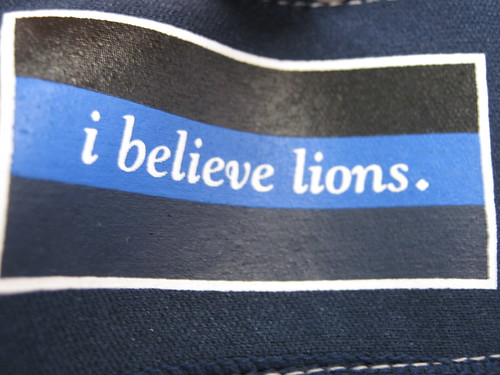 [/caption]
[/caption]
After an intense and draining day, it was finally time to get back to Tokyo for the last leg of the main tour and to catch some more baseball action!
It’s hard not to love Hiroshima and the Chūgoku region in general. Nowhere else in Japan did I see such devotion to a baseball team as I did in Chūgoku. Convenience stores in both the smallest regional stations and the largest Shinkansen stations sell Hiroshima Carp tea, Hiroshima Carp trinkets, and even Hiroshima Carp onigiri.
[caption id="" align=“aligncenter” width=“500” caption=“I bought Hiroshima Carp-themed food as often as possible. Gotta support my favorite team!”]  [/caption]
[/caption]
The city had to pull itself out of extreme tragedy and I don’t think you can fault a place whose mayor personally sends a letter of protest in response to every single nuclear test that its known about since the city was reestablished. Tokyo has excitement, Kyoto has history, but Hiroshima seems to have a lot of heart and I dig that.
Unfortunately, Hiroshima is far from Tokyo, so most of our day was eaten up by a bullet train back.
[caption id="" align=“aligncenter” width=“500” caption=“When asked why he slept through the whole train ride, Dave responded, “There was no action.””] 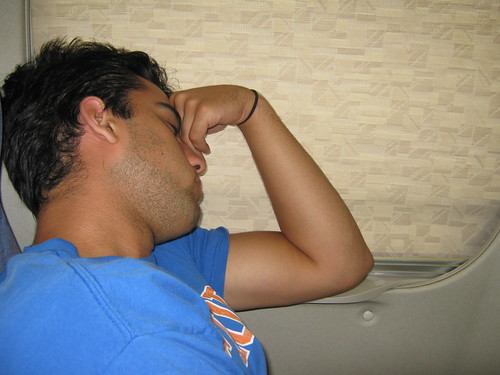 [/caption]
[/caption]
Have I mentioned that all shinkansen have snack carts that sell bentos, snacks, and drinks throughout the trip or that they’re punctual to a fault? Other than that, there’s not much to say. We got back to Tokyo, put our stuff down, had a bite to eat, and then began our journey to the Seibu Dome to see the Saitama Seibu Lions play.
I don’t know if I’ve talked about this before, but the most fundamental difference between Japanese baseball teams and American teams has got to be the corporate ownership. Sure, there are teams in America who have corporate shareholders or who are fully owned by a company, but I think that the culture is geared more toward a single owner, like George Steinbrenner, for example, rather than huge companies.
If you hadn’t guessed, it’s the opposite in Japan. The naming convention for most teams goes City/Area Name of Origin, Company Name, Team Name. So, in the case of the Lions, you have the city they’re in, Saitama, the company that runs them, Seibu, and the team name, Lions. It’s kind of complicated and it’s interesting that in most cases (the Carp excluded), the city gets left out and gets marginal billing. If you’ve heard of the Hokkaido Nippon-Ham Fighters, chances are you didn’t even know they were in Hokkaido, just that they were owned by Nippon-Ham (which consequently meant they had a funny name).
Why do I mention this? Well, as I’ve mentioned before, it was really seeming like none of the teams had any identity in their hometown. Sure, there was Tokyo Dome City for the Giants, but the area not immediately surrounding the stadium had almost no reference to the fact that the Giants played there.
All that changed when I noticed a lone sign in the train station on the way to the Seibu Dome.
[caption id="" align=“aligncenter” width=“500” caption=“It’s not anywhere near as dirty as it sounds.”] 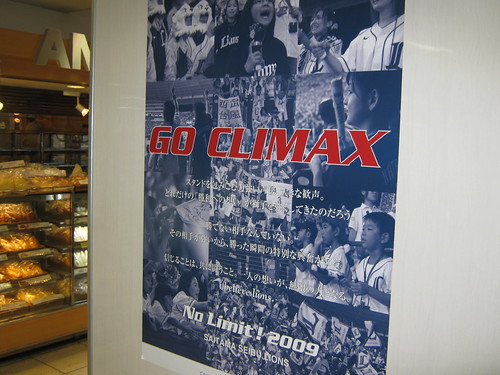 [/caption]
[/caption]
Finally! A poster representing the team we were going to see! Cryptic, bizarre, and slightly sexual message notwithstanding (explanation to follow), here was evidence that someone in Saitama loved the Lions.
The illusion came crashing down when I remembered one key fact: I was about to board a train on the Seibu line. While they’re certainly not the only team to own a private rail line that stopped at its stadium, Seibu was cheating, at least in terms of what I was looking for. Of course the company that owns the baseball team is going to advertise its team on the train that will eventually lead to its stadium. So, again, unlike Hiroshima, this was not a region that clearly adored its team, with decent reason, I suppose. Tokyo is a complicated city to love a team in, considering that there are four teams within a reasonable distance to root for (and most root for the Giants).
Now to address the poster. The playoff series in Japan is called the Climax Series. It makes sense when you think of the definition of climax, but it’s one of those things that you’d never see in the states without eliciting laughter (like when they tried to bring Calpis (read it aloud) to the states). The Climax Series is also unique in that, unlike the way it’s done in the states, it has only three teams competing in each league. The first place team gets a bye while the second and third slog it out in a best of 3. The next stage is a best of seven, but the first place team starts off with one win to reward their excellent play in the regular season. After that they play the Japan Series, which is the Japanese version of the World Series (also best of seven, but with no advantages).
On the Seibu line, we met some fellow baseball fans en route to the park. One of the fans was so devoted to the Lions that she had her toenails painted blue to show her support. The other girl was a closet Fighters fan who loved Yu Darvish, but explained that he just came off the DL, so he wouldn’t be pitching in that night’s game.
[caption id="" align=“aligncenter” width=“500” caption=“Save it for the athletic center!”]  [/caption]
[/caption]
Much like Skymark Stadium, the Seibu Dome stop was immediately adjacent to the Seibu Dome (how about that?), but the area was better decorated to reference the team with shops, stands, and blue Christmas lights.
[caption id="" align=“aligncenter” width=“500” caption=“The Seibu Dome…or is it?”] 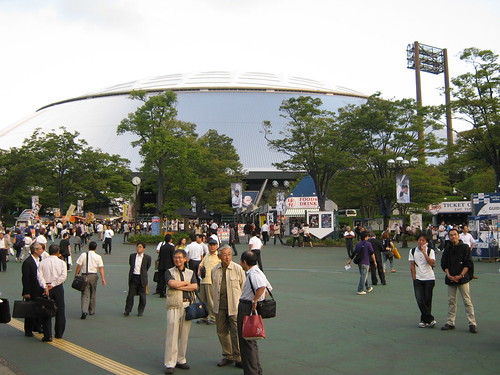 [/caption]
[/caption]
Dave and I wandered the area, taking in the sights, and I picked up a nice Lions jersey. While the quality was great, it turns out that the team is sponsored by Nike, meaning the jersey was a bit pricier than I had hoped. Another strange aspect of the jersey (beyond the “i believe lions” printed on the inside of the button flap) was that the armpits had “holes.” Maybe they were intended to allow better air circulation, but they’re just confusing and uncomfortable and it means you must wear an undershirt with the jersey, unless you want hair poking out of your underarms.
[caption id="" align=“aligncenter” width=“500” caption=“The Lions recognize good talent when they see it. Dave and I were immediately drafted onto the roster when we arrived.”] 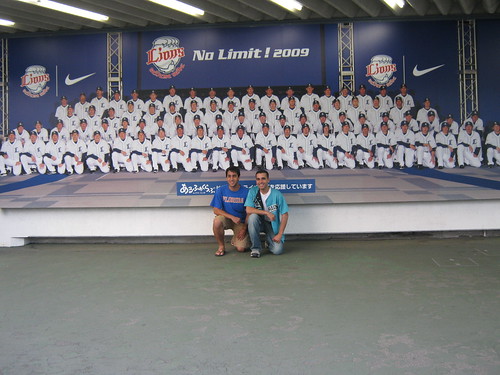 [/caption]
[/caption]
If you were paying attention to the captions, you’ll notice that I implied that the Seibu Dome was not actually a dome, and that’s with good reason. Instead of the hermetically-sealed, ears-pop-when-you-enter style dome that I experienced in Tokyo, this “dome” was simply a covering that went over the field. It was more like an umbrella than a dome. The stadium was open-air, more or less, aside from the non-retractable roof. This creates an interesting effect, according to a fellow tourgoer who lives on Yakota AFB and has adopted the Lions as his team, where the climate control performs terribly. On cold days, it’s unbearably cold while the real scorchers just feel even hotter underneath the canopy.
[caption id="" align=“aligncenter” width=“500” caption=“If you look closely, you can see the outside!”]  [/caption]
[/caption]
The Seibu Dome is a bizarre stadium construction, without a doubt. It feels more like a college ballpark or something you’d watch a dolphin show at Sea World in than a real baseball stadium, but that makes more sense when some context about the team is made clearer. Up until the Lions got 50 M$ (I believe (lions) that’s the figure) for posting Daisuke Matsuzaka to the Boston Red Sox, the teams financial situation had been relatively dire. It’s only natural that the ballpark be so strange when it was open air at first (no doubt cost considerations went into that) and that it not be converted to a real dome when the canopy was deemed necessary. That’s really part of the charm of baseball, when you think about it. The game is played with a standard set of rules in considerably non-standard locations.
[caption id="" align=“aligncenter” width=“500” caption=“Posing for a shot with Dave.”] 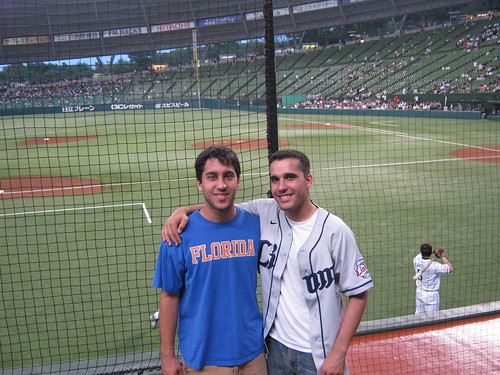 [/caption]
[/caption]
Frequent readers know I really don’t like dome baseball, but the Dome brings the best of both worlds, to the degree that one can have such a thing, by doing neither very well. I’d still prefer the pure, unhindered air on my face, but it definitely wasn’t as bad as the Tokyo Dome, so I can’t complain too much.
[caption id="" align=“aligncenter” width=“375” caption=“Hanging with the Colonel.”] 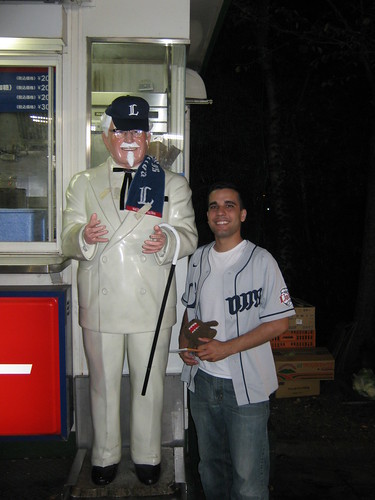 [/caption]
[/caption]
The start of the game heralded in something I’d yet to see in three Japanese baseball games, the Japanese national anthem. Jet lag may have prevented me from noticing at the first ballgame, but I quickly caught on to the fact that there didn’t seem to be a requirement to play the anthem before the game in these parts. I learned that the Japanese have a short national anthem too and that they seem to have different people come out and sing at each game, just like the ballparks in the states.
[caption id="" align=“aligncenter” width=“500” caption=“They may not play their national anthem, but they do have cheerleaders and beer girls.”] 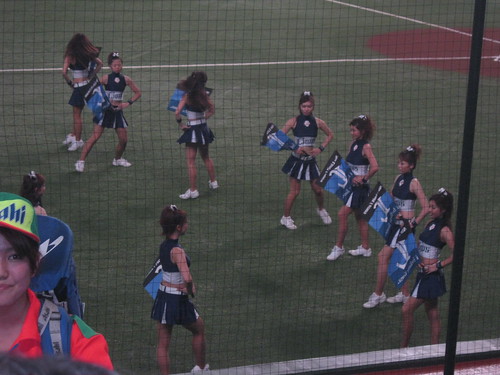 [/caption]
[/caption]
Much like Skymark Stadium, the Seibu Dome seemed to be pretty empty, which was strange considering that, unlike the Buffaloes, the Lions were in serious contention for the Climax Series. I’ll chalk the low attendance up to it being a Tuesday and leave it at that for now. Another interesting note is that their mascot resembles a grown up Kimba.
[caption id="" align=“aligncenter” width=“500” caption=“This is a cookie, but if you colored it all white, it would look more like the mascot who looks like Kimba.”] 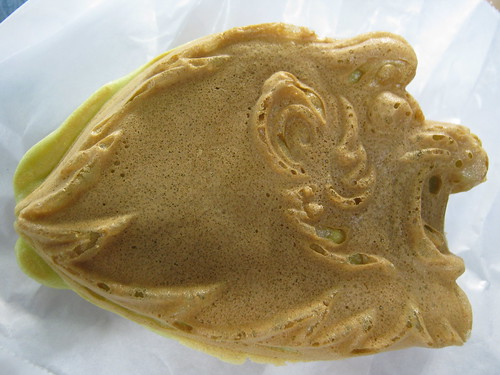 [/caption]
[/caption]
The reduced numbers didn’t prevent the Lions from displaying the same team pride and some of the raucous behavior I witnessed at the Carp game. Perhaps it’s due to alcohol, but there seemed to be an increasing number of fans who were more into it than others. Fans who yelled out things at players that weren’t synced up with cheers. It’s quite easy to drink too much at an American ballgame, but when you consider that the drinks keep flowing in Japan, even beyond the 7th inning (or two hours), you see that it’s easy to get that much wilder after your latest beer in the 9th.
[caption id="" align=“aligncenter” width=“375” caption=“A shot of me enjoying a fine drink at the Seibu Dome.”]  [/caption]
[/caption]
Also worth noting, the drink selection is not limited to beer. Most ballparks also have some serious hard alcohol being vended alongside the beer. At our first game in the Tokyo Dome, Mayumi and a guest bought some umeshu, plum wine, there’s plenty of soju, another rice alcohol from Korea, and I even got my hands on a delicious whiskey sour-type drink at the Lions game that packed quite a punch.
[caption id="" align=“aligncenter” width=“500” caption=“We made fast friends with this couple. She gave us a banner as a gift.”]  [/caption]
[/caption]
I don’t really have any new observations about the game itself, but it was notable in that it was the first home team victory we had on the tour so far. Thanks to that victory, we also got to see something that they definitely don’t do in the states, the on-field interview. The players of the game are usually rounded up and interviewed on the big screen for the fans that remain. Following the interview and a quick photo shoot, the players throw balls into the stands for the fans and head into the locker room.
[caption id="" align=“aligncenter” width=“500” caption=“Impromtu field press conference.”] 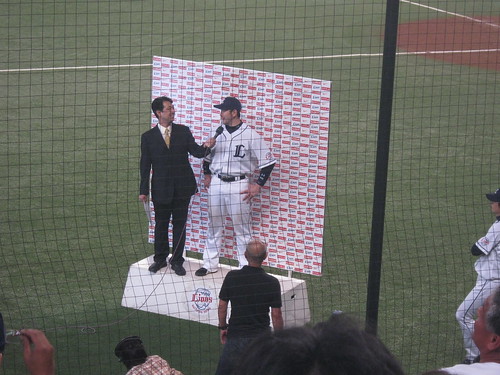 [/caption]
[/caption]
[caption id="" align=“aligncenter” width=“500” caption=“Pose for the cameras!”] 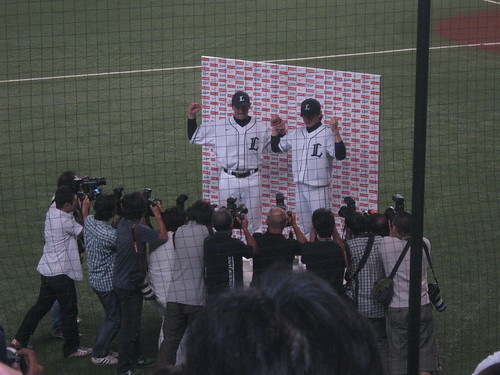 [/caption]
[/caption]
Another unique feature of the Seibu Dome is that they allow the fans to run the bases and toss the ball around the field after the game.
[caption id="" align=“aligncenter” width=“500” caption=“Fans celebrating on the field.”]  [/caption]
[/caption]
After we got our fill, we headed back to the hotel. It was the penultimate full day in Japan and David and I were ready to get our fill of Tokyo before he had to go home.
[caption id="" align=“aligncenter” width=“500” caption=“The area just outside the stadium at night.”]  [/caption]
[/caption]